Tradition in the Here and Now!
vol.2
Origami Art by Trial and Error
Nishida Shatner, Aichi prefecture
2015.05.25
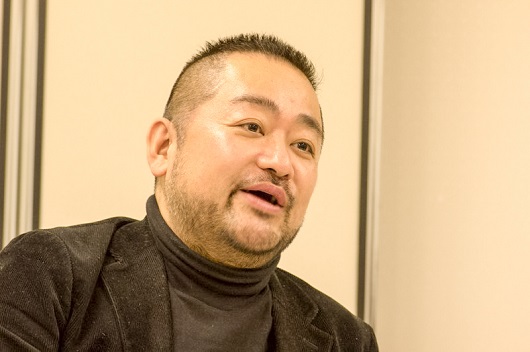
Almost anything--animals like rhinoceros beetles, stag beetles, or sheep and even imaginary creatures like the movie character Alien or the kappa imp of Japanese folk lore--takes shape in the original works of origami artist Nishida Shatner. Creating a work may take years, he says, and reminds him of the way a living creature--or even a universe--comes into being.
Hey, This Isn't a Crane!
The first time I did an original origami was back in second or third grade of elementary school. The most common origami is the "crane." Even little kids know how to make them, but to me it was like, "No! This is no crane!" As I saw it, the important elements of the shape of a crane--the long legs and graceful neck--were missing in the conventional origami crane. And besides--what is that crane doing, anyway! Who could tell.
Thinking that I ought to be able to fold something that looked more like a real crane, I gave it a try. And . . . I did it! I was satisfied--"Yes! This really looks like a crane!" But I didn't show my crane to anybody. I was too afraid of what they would say. In school we were always taught that you only made things according to the teacher's model, so I wasn't sure whether it was acceptable to diverge from the "model." Besides, I knew from experience that something that didn't follow the model would be ridiculed and laughed at: "What's that weird thing?" "You didn't follow the model!"
Fear of Being Different
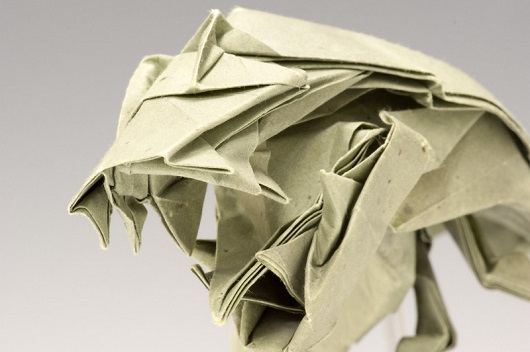
When I was in kindergarten, one day we all drew pictures of watermelon. But when I was done, everyone said my picture was "wrong"! It came as a real shock.
I am slightly red-green color-blind, so I did not see the color of the watermelon as bright red, and I had colored it in with brown. At the time I didn't know I was color blind, so I thought I was being laughed at even though, like everybody else, I had just drawn the watermelon the way I saw it. If we had been doing pencil sketches, my watermelon would have been better than that by the classmate sitting next to me, but my picture was laughed at and my classmate's was praised. If you draw just as you see something and get laughed at, I thought, what was I supposed to do? I didn't understand what was okay and what was a no-no. If you do something that is different from other people you will be laughed at? I was living without knowing what it was I was doing that was different from others or the same as others.
After that experience, when I folded an original origami crane that was different from the conventional one, I was overcome with the fear of having done something that was different from other people.
My Encounter with Origami Art
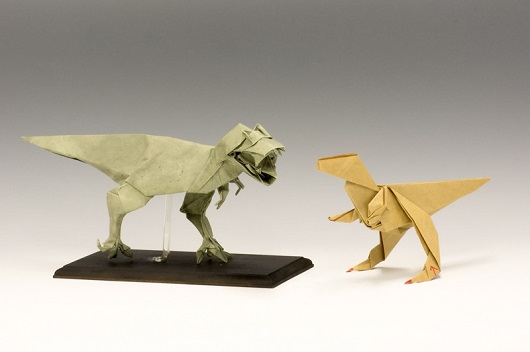
Once I began to make original origami, I found out that I was really pretty good at it. My mother seems to have realized early on that I had a talent for it. Then it was around when I was in fourth grade, I think, that my mother took me to a World Origami Fair, and I saw works made by origami artists for the first time.
I clearly remember one work by David Brill--it had people on horseback, showing them in action--horses galloping along! Around them there was a pack of dogs. The title was "Fox Hunt." Another one, though I forget the name of the artist, was of a butterfly emerging from the chrysalis. The title was "Life." Then I realized--origami is not something you do just from a model. These artists were creating origami to express what they saw in their own world.
I got really excited! There was this whole new world of origami, and I knew that my own skills were moving along a good trajectory.
My mother was my faithful fan and she always gave me praise. I don't think I could have continued with my origami without it. Mother also carefully put away the original pieces I made when I was small. Some of them are pretty good even when I look at them now. One was of the Thief Lupin. It was a very simple, basic figure, with the top hat and the cape, but I'd done a good job. I even had natural-looking wrinkles in his slacks.
Origami Is for Children?
Origami is of course well established in Japan, and it's a major cultural tradition in that even children can do it. However, because of that image, some people look at my works, thinking origami is just easy child's play, and they ask me "we'd like you to teach us how to fold that work" or "teach us something the children can fold, too."
But think of other forms of art? Do people ask the artists questions like that? The point is not to suddenly get the idea that you can copy someone else's origami. The first thing is to learn to freely fold whatever you want. I believe that if you want to nurture creativity, that is where you should start--and only after that, if you need to acquire some skill or technique you can ask someone for advice. The point is that there is nothing wrong with the conventional origami crane.
Originality should be nothing special, anywhere, even in the world of origami.
My Origami Moratorium
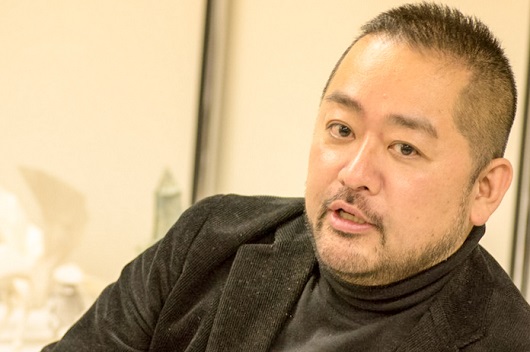
In junior high and the beginning of senior high school, I didn't do much origami. In those years, I didn't have the courage to tell people that my hobby was origami. I didn't know how to explain how serious I was about origami, and in Japan there is the preconceived notion that it is just play; recognition of origami as an art has not yet taken hold.
In high school it happened several times that classmates went into hospital. Whenever that happens, it's the standard practice for everyone to get together and fold a "thousand cranes" (senbazuru). Those who fold a thousand paper cranes will be granted their wish, it is believed, such as for the rapid recovery of someone who is sick. Each time, I did my assigned number of cranes, but I was done really fast, so I spent the rest of the time (while everyone else was still doing theirs) folding other things. And I found my fingers itching to going on folding! I had a kind of concentrated "fit" of folding that lasted about 10 days.
Outdoing Yourself
In second year of high school, on one of these occasions when we were all folding cranes for someone who was sick, and the guy next to me boasted, "I'm really good at origami" and showed me his origami, which was not bad. "I can make even better ones," I said, "Origami is a whole lot more amazing than you guys have any idea! You should see the origami people in other parts of the world are making." Then they challenged me, "You may say that, but you can't make origami of just anything. I bet you can't fold the Alien." (That was back when the movie Alien was all the rage.) Stumped for the moment, I was only able to make some vague response. But after I got home, I thought "I've got to show them," so I tried making Alien. And I actually did it! So the next day, I took it to school, and everybody was like, "Hey! That's brilliant!" and for a while origami was big in our class.
I think it was quite a big jolt for my classmates to realize that "hey, we can make origami Aliens or whatever!" I remember what great fun we had discussing what to make. One friend made an origami King Ghidorah. I could tell that everyone was really having fun with the origami.
As it turned out, making that Alien origami was a turning point for me. Until I made Alien, I had taken a lot of time to make one work and thought that even if I decided to fold something I wouldn't be able to finish it off in a day. But when I set out to make Alien, I finished overnight. It was my first experience of being filled with kind of creative explosion. I surprised even myself that I could do something like that.
Decision to Be an Origami Artist
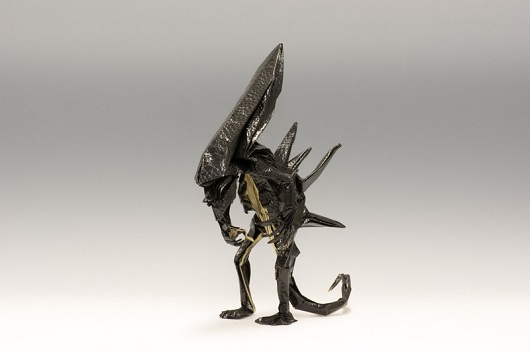
It was right after I had made Alien that I learned that a kind of industrial revolution was going on in the world of origami. People were using computers to design origami works. My approach had always been to fashion my works by trial and error, so I thought I would never be a match for that sort of sophistication. Foolishly, I just gave up. When I thought I'd never be able to be the best, my enthusiasm fizzled and I ceased to take it seriously. I still made origami but I didn't show them to anybody.
That went on for 25 years! Finally, in 2004 I couldn't suppress my attachment to origami any more, and I began to work on some serious origami art works. By around 2007 I had developed a feeling that I wasn't doing justice to the works by refusing to commit myself to the art. I have loved origami since I was small, and finally I decided to call myself an "origami artist."
By then I had developed a feeling that it was not so much me who was the creator of these works as that I was just a kind of instrument that allowed the work to emerge from the paper. The paper seemed to have a shape that it wanted to assume. You can force the paper to fold into whatever you want, but I felt I could tell when the paper suffered from being forced to fold in an unnatural way.
Even more than before, I felt I could sense how the paper "wanted" to be folded. Now I can feel a kind of intuitive interplay between my fingers and the paper.
Trial and Error
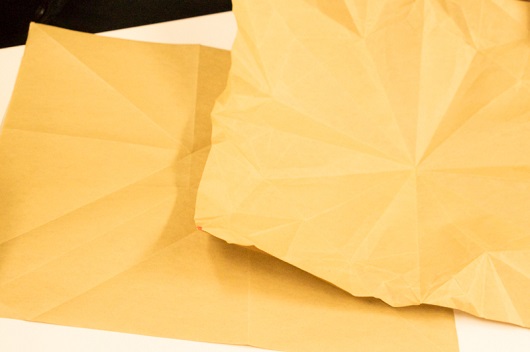
My approach to origami has been one of trial and error from the beginning. I never know exactly how I will fold a work before I begin. As I work, I figure out how I can get the forms and lines that I want, I open up the paper and study where to insert new folds and then start over with a new sheet of paper. As I proceed, if I think I'm taking the wrong tack, I go back, unfolding the paper and studying it again, then go back and try again with another new sheet of paper--over and over.
That's actually the way living things evolve. The way a single sheet of paper gradually takes shape is just like the way cells divide and subdivide until a living thing is born. It even seems like the way a universe comes into being.
The Elusive "Finish"
Even when I realize I've managed to finish a work, it's not as if it is somehow the perfected form. I'm always going back to a work and attempting to do a better version. Most of my works today are ones I have been working on for several years. Even these are not what I would call "complete."
My Alien today is really the culmination of 20 years of folding it since I was in high school. Back in high school, I didn't think I could do these big fingers of Alien, but after I turned 40 and got really serious about it, I folded in the fingers.
When I succeed in doing something I realize that my notion that "I can't" has gotten in the way. I just hadn't really taken up the challenge.
Even though I want to make all sorts of works, years and months pass when I feel I can't do it and don't try. But when I once make up my mind, I can do it. I've had that experience now a number of times, and yet I still sometimes lack confidence. The thing about an art like this is that when the time is right, there's a realm in which one outdoes one's own ability. You just think to yourself that you can't do something, when actually you can. I have now come to believe that we live in a universe in which almost anything can happen.



